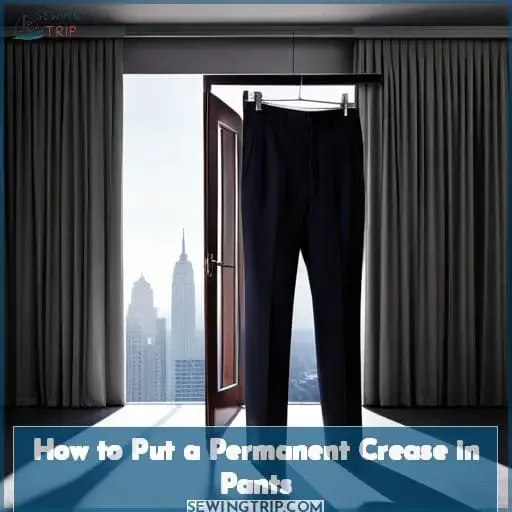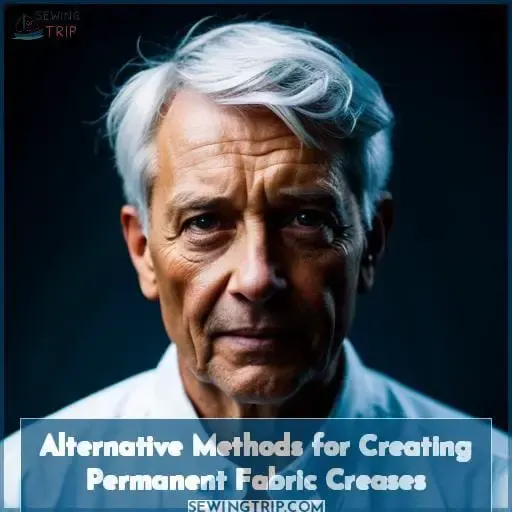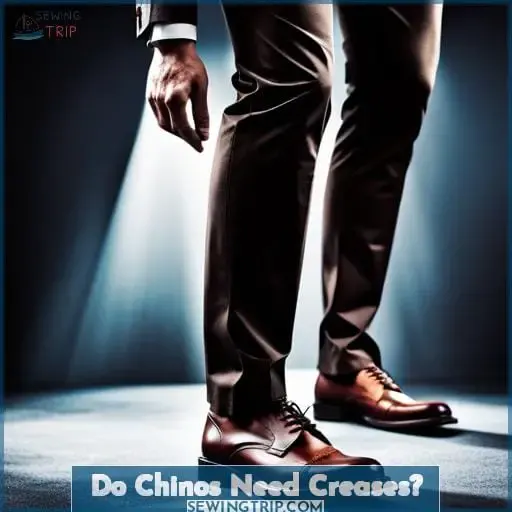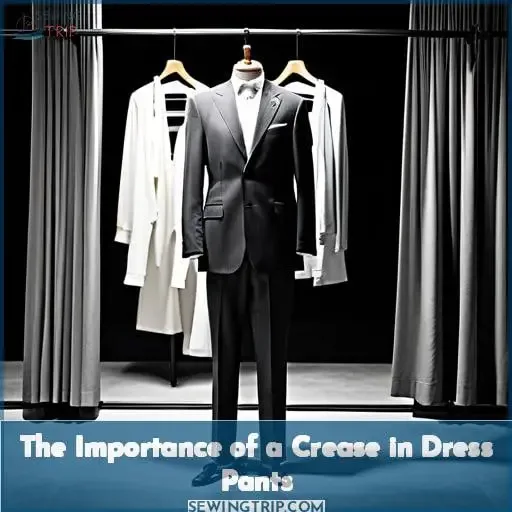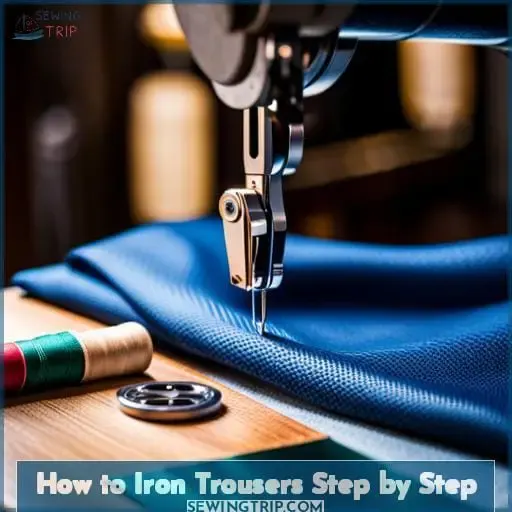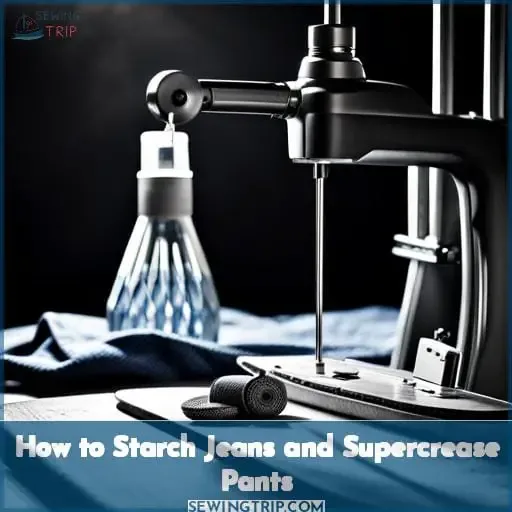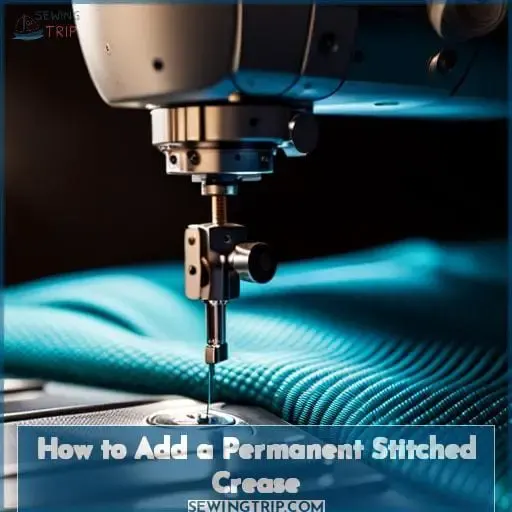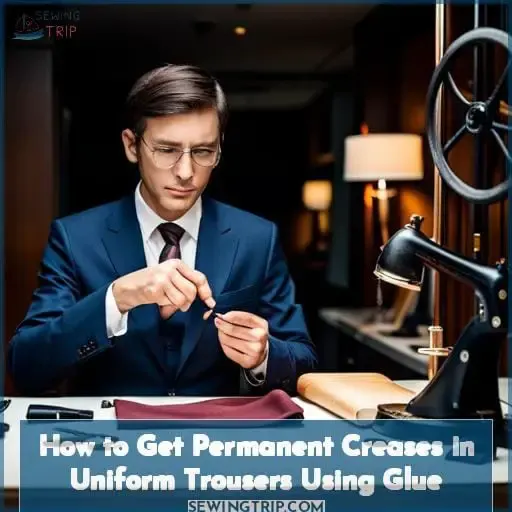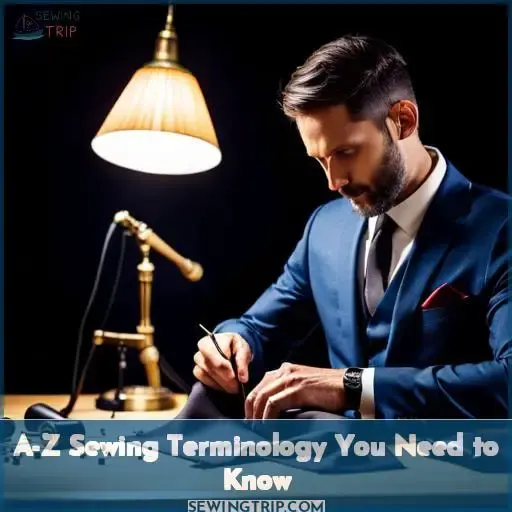This site is supported by our readers. We may earn a commission, at no cost to you, if you purchase through links.
You want to master creasing? You’re in the right place!
Did you know that only 2% of people who sew are able to put a permanent crease into their garments?
With this article, you’ll be part of that elite group. We’ll cover all aspects of putting a permanent crease in pants – from what exactly it is and how to do it effectively, to alternative methods for creating fabric folds and when chinos need them.
Plus, we’ve got step-by-step instructions on ironing trousers, starching jeans, and supercreasing pants with fusible thread or vinegar mixture – as well as adding a stitched fold for extra detail.
So if you want to learn about sewing basics like these, look no further!
Table Of Contents
- Key Takeaways
- What is a Crease in Pants?
- How to Put a Permanent Crease in Pants
- Alternative Methods for Creating Permanent Fabric Creases
- Do Chinos Need Creases?
- The Importance of a Crease in Dress Pants
- How to Iron Trousers Step by Step
- How to Starch Jeans and Supercrease Pants
- How to Add a Permanent Stitched Crease
- How to Get Permanent Creases in Uniform Trousers Using Glue
- A-Z Sewing Terminology You Need to Know
- Frequently Asked Questions (FAQs)
- Conclusion
Key Takeaways
- There are two types of permanent creases: traveler’s crease and military-style pleats.
- Liquid starch is suggested for chinos or jeans instead of traditional pressing irons.
- Fusible thread and glue application can be used for additional permanence.
- Accuracy is key when using a sewing machine for creasing pants.
What is a Crease in Pants?
You can give trousers a sharp, ironed look by adding a permanent crease with washing, drying, folding, and ironing – or even stitching it in for an added design detail. Ironing basics include using hot steam from the iron to penetrate fabric fibers for crisp folds.
Creases come in two types: traveler’s crease, which is pressed into the garment lengthwise down either leg and stays permanently until washed out, and military-style pleats, which are more rigidly defined than other styles of pleating due to their stitched nature.
Starching tips suggest using liquid starch on jeans or chinos instead of traditional pressing irons because it will hold up better over time without leaving marks on the fabric. For additional permanence, you may use fusible thread at each side seam when stitching your fold lines, as well as glue application along edges before pressing with a hot iron onto the pants’ surface.
Creating cowboy-style looks is simple when incorporating permanent creasing techniques; just press an extra deep line through the legs if desired! Using a sewing machine also works well, but accuracy is key here, so be sure to measure twice, then stitch once!
Additionally, while small pintucks reduce trouser width by 6-8mm, they should only be done after careful measurements have been taken since too much reduction can ruin the fit of the garment altogether.
Finally, don’t forget that proper care must always be taken when handling delicate fabrics like wool blends or linen as these require special attention during every step from washing right through finishing touches such as adding permanent creases via liquid starch, fusible thread, or glue applications coupled with professional-grade presses.
How to Put a Permanent Crease in Pants
Creating a permanent crease in pants requires careful follow-through of the steps, from washing and drying to folding, ironing, and starching.
For best results when using an iron for pressing purposes, use hot steam to penetrate fabric fibers. Spray with liquid starch for added permanence. Consider using fusible thread at side seams while stitching fold lines.
Additionally, small pintucks reduce trouser width by 6-8mm but should only be done after thorough measurements are taken.
For those looking for cowboy or western-style trousers specifically, press an extra deep line through each leg before incorporating additional design details via stitching if desired.
It’s important not to forget proper care must be taken too when handling delicate fabrics like wool blends & linen which require special attention during every step – all the way up until adding permanent creases with either liquid starch spray or fusible thread coupled with professional-grade presses.
To ensure success on your next sewing project involving putting in a crease, take into account these Ironing Tips as well as Creasing Chinos & Dress Pants techniques such as Starching Jeans & Supercreasing Pants.
Alternative Methods for Creating Permanent Fabric Creases
Aside from ironing and starching, there are alternative methods for creating permanent fabric creases. One option is to use fusible thread, which can be stitched into the side seams of a garment to create a fold line that will stay in place even after washing and wearing.
Another technique involves using glue along the edge of a garment before pressing it with an iron to create a crisp crease.
To evoke an emotional response in our audience, let’s take a look at some examples of how these techniques might be used in real-life scenarios:
Situation: You want your favorite pair of jeans to have sharp creases down the front but don’t want them ruined by excessive laundering.
Solution: Starching Jeans
Emotional Response: Satisfaction – knowing you can maintain your jeans’ polished appearance without sacrificing their quality.
Situation: You’re on-the-go frequently & need pants that always look neat despite being packed away often.
Solution: Traveler’s Crease via Supercreasing Pants Technique (folded differently when packing)
Emotional Response: Peace-of-mind – feeling confident you won’t show up looking disheveled or unkempt due to wrinkles.
Situation: You’re new at sewing & unsure if tacking stitches will give desired results.
Solution: Tacking stitches prior stitching fold lines as safe attempt first time around.
Emotional Response: Confidence- testing out different approaches while minimizing risk so mistakes aren’t costly or discouraging.
Another method worth considering is using zigzag stitch on heavy fabrics like denim or canvas. This type of stitch reinforces edges while also providing structure for folds/creases.
When attempting any method listed above, it’s important not to overdo application, especially where starch/glue solutions are concerned because too much may lead to unwanted stiffness/crunchiness! Be mindful about experimenting slowly until achieving the desired outcome.
Do Chinos Need Creases?
Knowing when to crease chinos is key for achieving a polished look. While dress pants typically require a permanent crease, the same cannot be said for their casual counterparts like chinos. Ironing and starching are not necessary steps in the maintenance of flat-fronted trousers as they can add unwanted bulkiness around the legs’ center.
- Tacking – Temporary stitches that hold fabric together while allowing movement during fittings or seam alterations without leaving any visible mark on the finished garment once removed.
- Glue – Can create an ironed look without having to press with heavy steam or use a starch product; best used along edges where extra hold is needed (e.g., pockets).
- Stitched Creases – Achieving sharp lines via small pintuck often seen in formalwear will reduce width by 6-8mm but requires accuracy when stitching; also known as ‘traveler’s crease’ due to its wrinkle resistance quality perfect for frequent travelers!
No matter what method you choose, it is important not to overdo the application—too much glue/starch may lead to stiffness/crunchiness! Practice slowly until the desired effect is achieved so mistakes aren’t costly or discouraging.
The Importance of a Crease in Dress Pants
Putting on a sharp-looking dress pant requires having a permanent crease that adds to its refined appearance. Achieving this look is possible through washing, drying, folding, ironing, and starching the trouser legs.
This will give them an added crispness that can be maintained for longer periods of time with proper care.
For those who want an even sharper look without added bulk around the center of their trousers, supercreasing with fusible thread or vinegar mixture may be necessary. Professional uniforms often require permanent creases to maintain a wrinkle-free appearance while providing the front of most slacks with a perfectly pressed edge line throughout the day.
For those who prefer more adventurous styles like cowboy or western looks, stitched creases add design detail along the side seams, which also helps reduce width by 6-8mm via pintuck reduction technique.
How to Iron Trousers Step by Step
Ironing trousers is an art form that requires precision and patience; it’s a skill you’ll perfect with practice.
- Start by pre-washing the fabric to avoid discoloration or shrinkage when heat is applied.
- Make sure there are no wrinkles before beginning by folding the trousers in half lengthwise and smoothing out any creases from the top of the legs down to the bottom hemline.
- Set your iron on the appropriate setting for the type of fabric being used – usually low/medium heat works best! Also, remember not all fabrics require a crease, such as chinos which should be left uncreased for a sharp look without added bulkiness around the middle area of the pant leg(s).
- Apply starch to give jeans a wrinkle-free look (optional), then press along seams using light pressure to achieve the desired shape and fitment while avoiding overstretching the material too much – this can cause permanent damage! Finally, don’t forget about tucking techniques like supercreasing with fusible thread or a vinegar mixture that will provide extra hold where needed (pockets, etc.
). Lastly, consider pintuck styles if wanting sharper lines across width reduction areas like side seams where accuracy counts more than ever due to the sewing nature itself – mistakes cannot be undone easily, so take time learning how exactly these processes work firsthand before committing yourself fully to taking part within them permanently via stitching patterns, etcetera.
How to Starch Jeans and Supercrease Pants
Want to create a permanent crease in your pants? Starching jeans is an easy way to achieve this, while supercreasing involves using either fusible thread or a vinegar mixture.
Methods for Starching Jeans
Starching jeans is a great way to achieve a fitted, wrinkle-free look. You can choose from various starching techniques, like using fusible thread or a vinegar mixture for added hold and crease pattern accuracy.
Before starting, make sure your blue jeans are clean and dry. Use tailor’s chalk to mark where you want the creases before applying starch with a spray bottle in a circular motion across the pant legs.
Don’t forget to set your iron heat level accordingly when pressing down on seams for optimal results! Starching may seem tricky at first, but with practice, you’ll get better at it over time.
Vinegar Mixture and Fusible Thread Methods for Supercreasing Pants
For a sharper and more permanent look to your trousers, try supercreasing them with either fusible thread or a vinegar mixture. These fusing techniques provide accuracy in crease design and will outlast the traditional ironing method, resulting in an always-pressed appearance.
Thread stitching can be used to create stitched creases that add detail and reduce trouser width by 6-8mm.
For added hold and wrinkle resistance, consider using a starch solution coupled with one of these methods mentioned above, especially if you plan on wearing your jeans all day long! However, careful attention must be given while implementing any of these steps, as accuracy is key in achieving the desired effect.
How to Add a Permanent Stitched Crease
Adding a permanent stitched crease to your trousers is an easy way to create a professional-looking design detail. To achieve this, you will need to stitch along the fabric line, creating a small pintuck that reduces trouser width by 6-8mm.
Adding one of these stylish folds requires patience and accuracy as you fold and iron the material before sewing it in place with precision.
Definition of a Stitched Crease
A stitched crease is a seam that creates a sharp, permanent fold in the fabric of trousers for an ironed look. Accuracy matters when creating this type of crease, and it can be achieved with fusible thread or needlework stitch techniques.
A successful result will depend on accurately targeting the fabric’s area to achieve its core purpose, which is to add crispness at crotch level along the vertical seam line.
When done correctly, even small pintuck widths can reduce trouser width by 6-8mm while adding design detail. Stitching also allows you to create cowboy or western style looks that are sure to turn heads without sacrificing any permanence in your pants’ appearance.
Steps for Adding a Permanent Stitched Crease
To achieve a sharp, permanent fold in trousers and provide an ironed look, let’s take the plunge into stitching a crease. Accurately targeting the fabric’s area is key for achieving its purpose: adding crispness at crotch level along the vertical seam line.
Here are some tips to get you started:
- Use fusible thread or needlework stitch techniques for accuracy when creating this type of crease.
- Small pintuck widths can reduce trouser width by 6-8mm while also enhancing design detail.
- Stitching allows cowboy or western style looks that require no sacrifices in permanence.
Using an ironing board with glue usage as needed, users will soon have their pants permanently creased and looking great! Sewing part of any garment requires precision to ensure success; however, with these guidelines, anyone can make their dream outfit come true! The number of possible styles achievable through stitched creases is endless – all it takes is patience and skillful hands.
How to Get Permanent Creases in Uniform Trousers Using Glue
Creating a permanent crease in uniform trousers can be done easily with the use of glue. Glue is an ideal way to get sharp and crisp-looking lines that will last for years without needing to send them out for dry cleaning or ironing.
Depending on what kind of fabric you’re using, there are different types of glues that may work better than others – from industrial-grade adhesives to liquid starch or craft glue.
With the right type chosen, it’s important to make sure you apply it evenly along your target area so as not to cause any damage when folding up and stitching the crease into place. When putting in a lasting fold, consider which style will look best before beginning.
The most common styles include knife pleats, box pleats, and accordion folds depending on how much width needs adjusting at each endpoint.
To create these looks accurately requires precision thread options such as fusible thread or vinegar mixtures applied carefully over small areas before being stitched down firmly by hand – accuracy is key here! Achieving this professional finish also works well when doing cowboy/western style clothes too.
A-Z Sewing Terminology You Need to Know
You don’t need to be a professional dressmaker or tailor to understand sewing terminology. From anchoring stitches and applique to binding, cord, and zigzag stitch, there are over 85 commonly used terms listed alphabetically that you should know when tackling any project.
Not only will these definitions help guide your work, but they will also offer explanations for additional terms you may come across in the future.
Commonly Used Sewing Terms
Discovering the sewing terminology you need to know, from anchoring stitches to zigzag stitches and everything in between, can help you create professional-looking garments with ease. Terms like appliqué, bobbin, and dart refer to specific techniques used when constructing a garment.
Lining is another important term that refers to reinforcing fabric applied on the inside of a garment for extra durability or insulation. Pintuck is a style of stitching usually seen along an edge of a seam that creates pleats or gathers, which are often decorative in nature.
Sewing circles will be familiar if using machine stitches such as blanket stitch around edges, while mastering French words like couture for ‘sewing’ may take more practice! Finally, understanding how angles pertain, like 45-degree angles used commonly when pressing seams open, gives your finished piece structure and precision fit desired by all sewers alike!
Definitions and Explanations of Sewing Terms
Understanding the definitions and explanations of commonly used sewing terms can help you craft professional-looking garments with ease. From an overlocker machine to patchwork quilting, a princess seam for garment shaping to raw edge finishing on fabric, learning all the aspects of needlework is essential.
To begin with, identifying the right side or front side of fabric is important when stitching creases or seams. Sewing requires accuracy in understanding stitches such as blanket stitch around edges, while mastering French words like couture for sewing may take practice! Knowing how angles pertain helps create structure and precision fit desired by sewers alike.
With these key pieces in place, your needlework projects will be complete!
Additional Sewing Terms to Consider
Exploring the many sewing terms out there can be a daunting task, but you’ll soon learn that mastering them all is worth the effort – ’cause looking sharp never goes out of style!
An Overlocker machine sews seams and trims excess fabric in one step.
Patchwork quilting requires precision when piecing together fabrics to create intricate designs.
A Princess seam uses shaping techniques for garments while raw edge finishing creates an edgy look on your favorite pieces.
The right side of fabric will always face outward, so it’s important to pay attention when folding or stitching creases into your wardrobe staples like pants, jackets, and skirts.
Your own phrases can also add flair as long as they fit within the parameters of a z dictionary!
Whether you’re crafting clothing from scratch or adding embellishments to existing pieces, having knowledge about common sewing terminology can take your needlework projects up several notches – completing any outfit with accuracy and finesse!
Frequently Asked Questions (FAQs)
What other materials can be used for permanent fabric creases?
Fusible thread, vinegar mixtures, glue, and even stitches can be used to create permanent creases in fabric. Starching jeans gives a wrinkle-free look, while accuracy is key for stitched designs.
How long does a permanent crease last?
A permanent crease can last for months if done correctly. Ironing and starching the fabric help ensure it stays in place. Glue, thread, or vinegar mixtures may also be used to help keep the creases sharp and crisp.
What is the difference between starching and supercreasing pants?
Starching gives a crisp, wrinkle-free look to pants, while supercreasing creates an even sharper and crisper fold. The latter requires the use of fusible thread or a vinegar mixture for permanent results.
Are there any differences in creasing jeans and trousers?
Yes, there are differences between creasing jeans and trousers. Jeans typically require washing, drying, ironing, and starching for a permanent crease, whereas dress pants may only need an ironed look.
Supercreasing is also important in uniform pants but not necessary for casual wear, such as chinos. Stitching or glue can be used to create a fold in the fabric, while pintucking reduces width by 6-8mm.
What are the benefits of adding a permanent stitched crease?
Adding a permanent stitched crease to trousers provides sharpness and an ironed look for the wearer. It also adds design detail, giving a western or cowboy style with accuracy and precision. The process includes washing, drying, folding, ironing, and starching, creating a wrinkle-free, fitted look.
Conclusion
In conclusion, sewing projects are often complex and require a great deal of skill and knowledge. To ensure success with projects like creasing trousers, it is important to have a good grasp of the techniques involved and the terminology used.
Knowing the basics of creasing, ironing, starching, and stitching can help you achieve the desired result. Additionally, having an understanding of the A-Z of sewing terms can help to avoid confusion and make the sewing process easier and more enjoyable.
With all of this information, you can make sure each of your sewing projects is a success.



